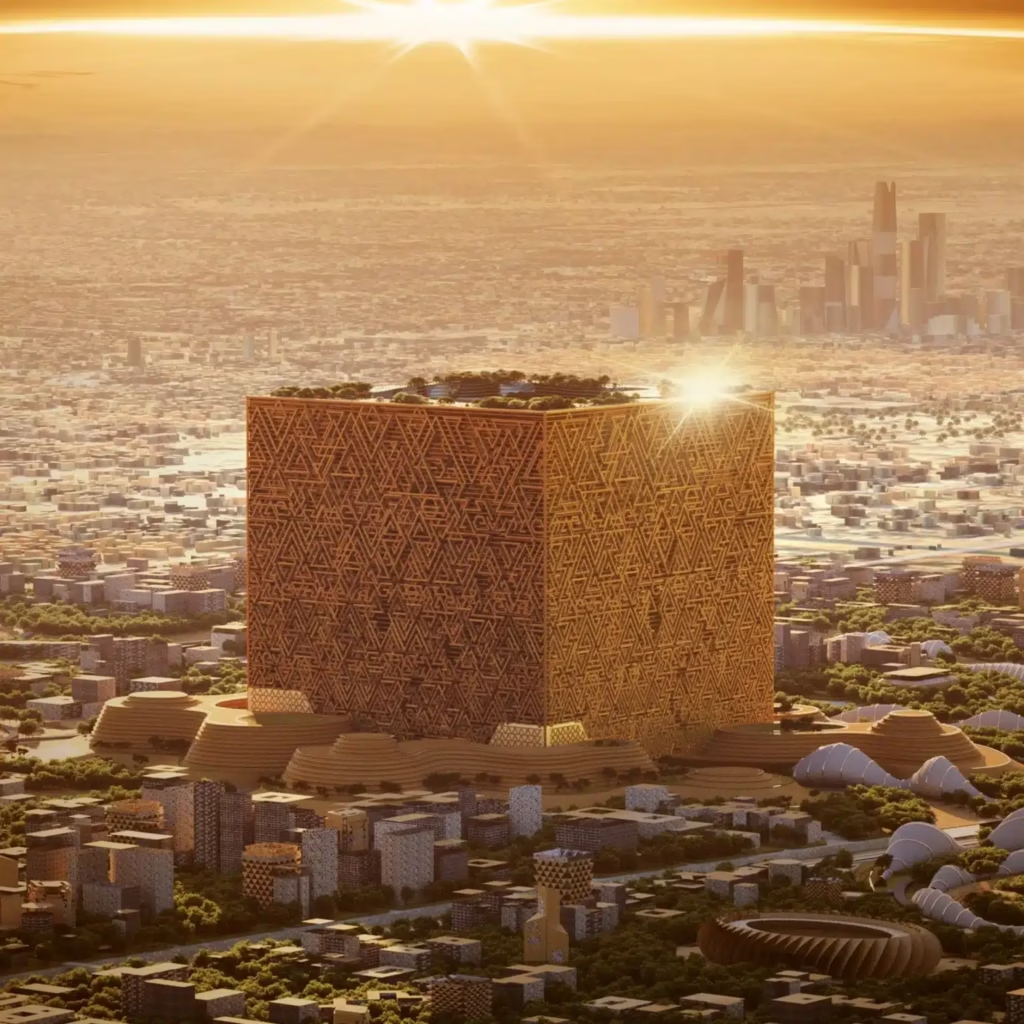
The Mukaab: A Monumental Vision or a Misguided Marvel?
The Mukaab – Saudi Arabia’s relentless pursuit of architectural grandeur and futuristic urban living has culminated in the unveiling of it, a colossal cube-shaped structure poised to redefine Riyadh’s skyline and potentially reshape the global architectural landscape. Crown Prince Mohammed bin Salman’s ambitious vision, materialized through the New Murabba Development Company (NMDC), aims to create a new global icon, a testament to Saudi innovation, technological prowess, and sustainable urban development. However, the sheer scale and audacious design of The Mukaab have not been without controversy, sparking debates about its cultural sensitivity, architectural inspiration, and the ethical implications of its construction.
A City Within a Cube: Unveiling the Mukaab’s Magnificence
Described as a “super-city” enclosed within a 400-meter-high, wide, and long cube, The Mukaab’s sheer size is staggering. Its internal volume is projected to be large enough to accommodate 20 Empire State Buildings, a feat of engineering that underscores the project’s monumental ambition. Located at the heart of the New Murabba Development, a sprawling 19-square-kilometer area northwest of Riyadh, The Mukaab is strategically positioned at the intersection of King Salman and King Khalid roads, promising to become a central hub for the burgeoning metropolis.
The New Murabba Development, with The Mukaab as its centerpiece, is envisioned as a self-contained urban ecosystem. It is projected to house hundreds of thousands of residents and offer a comprehensive array of amenities and facilities. The development plans boast over 25 million square meters of floor area, encompassing more than 104,000 residential units, 9,000 hotel rooms, and over 980,000 square meters of retail space.
Furthermore, the project will feature 1.4 million square meters of office space, 620,000 square meters of leisure assets, and 1.8 million square meters dedicated to community facilities. This ambitious undertaking is anticipated to generate 334,000 direct and indirect jobs and contribute SAR 180 billion (US$47.98 billion) to the national GDP, underscoring its significant economic impact.
Inside The Mukaab, a spiraling base will house premium hospitality units, retail spaces, and tourist attractions, creating a vibrant and dynamic internal environment. The structure will also encompass over 80 entertainment and cultural venues, a museum, a tech and design university, and a theatre, fostering a rich and diverse cultural landscape. One of the most ambitious features of The Mukaab is the “world’s first fully enclosed skyscraper,” a testament to the project’s innovative spirit.
Adding to the futuristic allure, a dome within the cube will project holographic images, creating immersive experiences for hotel guests, transporting them virtually to different regions of the world, complete with sensory simulations of sights, smells, and tactile sensations.
Architectural Inspiration and Cultural Controversy: The Cube’s Dual Nature
The architectural design of The Mukaab, with its overlapping triangular forms, draws inspiration from the Najd region’s traditional architecture. This nod to local heritage aims to ground the futuristic structure in Saudi Arabia’s cultural identity. However, the cube’s shape has ignited controversy, with some critics drawing parallels to the Kaaba in Mecca, the holiest site in Islam. The Kaaba’s cubic form is central to Islamic prayer and pilgrimage, and its significance is deeply ingrained in Muslim tradition. Critics argue that The Mukaab’s resemblance to the Kaaba is a deliberate affront, a symbol of idolatry that disrespects the sanctity of the holy site.
In response to these criticisms, proponents of The Mukaab argue that the structure’s design is inspired by the Murabba Palace, a historical landmark in Riyadh. While the Murabba Palace, completed in 1938, shares the “square” nomenclature, it does not possess the cubic form or the monumental scale of The Mukaab. This defense has done little to quell the concerns of those who perceive the cube’s shape as a cultural misstep. The controversy highlights the delicate balance between architectural innovation and cultural sensitivity, particularly in a region with deep religious and historical traditions.
A Giga-Project Among Giants: Saudi Arabia’s Ambitious Vision
The Mukaab is not an isolated project but rather a key component of Saudi Arabia’s broader strategy to diversify its economy, modernize its infrastructure, and establish itself as a global leader in innovation and sustainable development. It stands alongside other ambitious giga-projects, including NEOM, a futuristic city under construction, featuring The Line, a 170-kilometer-long linear city, and Sindalah, a luxury island resort on the Red Sea. These projects, driven by the Crown Prince’s Vision 2030 plan, represent a massive investment in the future of Saudi Arabia.
However, the rapid pace of development and the sheer scale of these projects have raised concerns about labor practices and human rights. Recent reports have alleged that workers on NEOM’s The Line project have been subjected to grueling hours and exploitative working conditions, exceeding legal limits and raising ethical questions about the human cost of these ambitious endeavors. These allegations cast a shadow over the narrative of progress and innovation, highlighting the importance of ensuring ethical and sustainable practices in the pursuit of architectural and urban marvels.
The Mukaab: A Symbol of Transformation or a Monument to Controversy?
The Mukaab represents a bold vision for the future of Riyadh and Saudi Arabia. It is a testament to the nation’s ambition, its technological prowess, and its desire to create a new global landmark. The project’s sheer scale, innovative features, and potential economic impact are undeniable. However, the controversy surrounding its design, particularly its resemblance to the Kaaba, cannot be ignored. The Mukaab’s legacy will depend on how these concerns are addressed and whether the project can successfully integrate architectural innovation with cultural sensitivity and ethical labor practices.
As construction progresses and the 2030 completion date approaches, the world will be watching to see whether The Mukaab becomes a symbol of transformative progress or a monument to miscalculated ambition. The project’s ultimate success will hinge not only on its architectural grandeur but also on its ability to navigate the complex interplay of innovation, culture, and ethics in the 21st century.
More News : visit> bulletinbuzzs